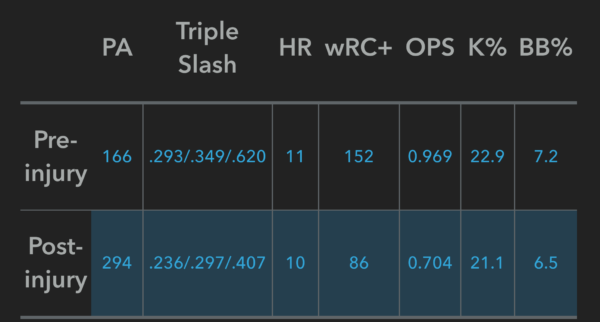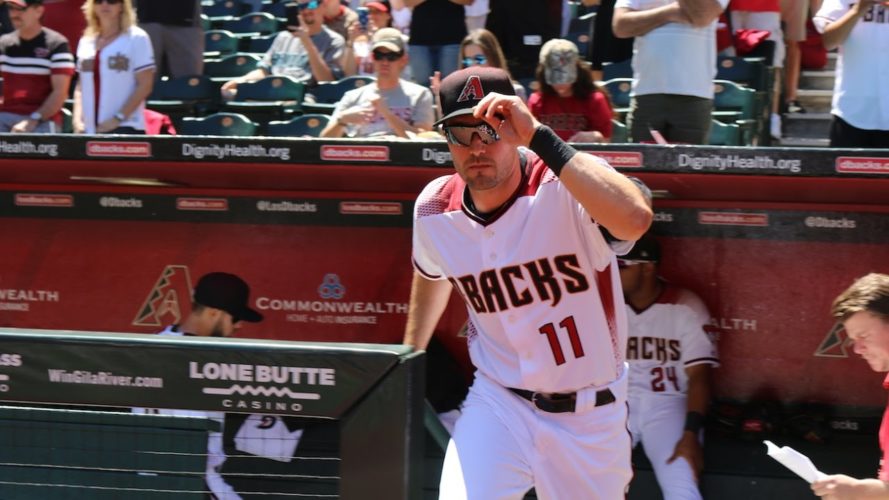The Dodgers got their right-handed bat a few days ago, as they signed CF A.J. Pollock to a four-year contract with a fifth-year option that could be worth around $60 million. It’s the biggest contract given by this front office to a player that wasn’t being re-signed, and it’s the first contract of more than three years to be given to a position player this offseason. It won’t be the last, as Bryce Harper and Manny Machado are still unemployed a few weeks before pitchers and catchers report for Spring Training. This system is great, guys.
Barring something unforeseen, this should be the big Dodger signing of the offseason. There’s still rumblings about a J.T. Realmuto trade, but for now Pollock is the big splash of the offseason. That’s a disappointment if you were expecting Harper or Machado, and it’s perfectly reasonable to be disappointed in the Dodgers not adding one of those two players. 28 teams’ fanbases should be disappointed about their team not adding one of those two. However, that doesn’t mean that signing Pollock was a bad idea.
——
The fit does make sense, as before signing Pollock, the Dodgers were awfully left handed. While I covered why they shouldn’t care about this too much back in December, Pollock’s signing does give them an everyday right-handed outfielder that can play center field. Still, many have pointed out that he struggled against lefties last season, posting a .221/.277/.464 triple slash against southpaws last season in 155 plate appearances. But even that was still good for a .742 OPS and a 91 wRC+, and relevantly it represented a definite down year for Pollock against lefties. In 2017, Pollock OPS’d .854 with a 113 wRC+ against lefties and in 2015, he OPS’d .881 with a 131 wRC+.
Now 2015 was a long time ago, and that was the last season Pollock didn’t miss significant time with an injury. In 2016, Pollock slid into home during an exhibition game and fractured his elbow, costing him all but 12 games that season. In 2017, Pollock missed nearly two months with a groin strain, and in 2018, Pollock broke his thumb diving in the outfield, costing him about six weeks. Weirdly enough, both of these injuries occurred on May 14th (if he’s out of the lineup this May 14 against the Padres, you know why). Notably that’s only one soft tissue injury, and when Pollock has played over the last two seasons, he has been pretty good. In 926 plate appearances since the beginning of the 2017 season, Pollock has a .266/.323/.477 triple slash with 35 dongs and 33 stolen bases in 41 attempts. Playing in Arizona in 2017 surely aided his overall numbers, although he kept fairly consistent despite the addition of the humidor in 2018.
Additionally, there were a few areas where Pollock was elite offensively last season. Out of 214 players with at least 400 plate appearances, Pollock had the 10th-lowest “soft-hit rate” at 11.2 percent, and the 20th-best “hard-hit rate” at 44.6 percent. So he made the best contact of his career last season, but it did have a cost, as he struck out at a higher rate than he ever has in his career (21.7 percent) and nearly matched a career-low walk rate (6.7 percent).
——
Despite missing time in each of the last two seasons with injuries, Pollock has been productive, posting above-average fWAR’s of 2.2 and 2.5 in the last two seasons. While (most) fans are outraged that Pollock is “replacing” the beloved Yasiel Puig, the reality is that he has posted fWAR’s of 2.9 and 1.8 in the last two seasons, providing the same fWAR total but in a bit more extreme way. In 2017, Puig’s 2.9 fWAR came in 570 plate appearances, a number that Pollock has reached only once in his seven major league seasons. Durability is important and where Puig has a distinct advantage, and with the Dodgers cutting into their outfield depth, their ability to withstand another Pollock injury might be tested (which is why keeping Joc Pederson makes sense).
As far as upside is concerned, obviously Pollock’s 2015 provides a significant example of it. But even in 2018, Pollock was looking like an MVP candidate before getting injured. Here are his numbers pre- and post- injury.

So Pollock is a fine offensive player. He’s not a huge, lineup-changing bat, but he’s got a nice speed/power mix and should provide some consistency as he can handle both righties and lefties.
But another aspect of his game stands out, as Pollock gives the Dodgers the best defensive center fielder they’ve had in recent memory. He’s not the athlete that he used to be, but an outfield with Pollock, Cody Bellinger and Alex Verdugo has the chance to be one of the best defensive outfields in baseball.
——
When he’s healthy, Pollock is a very good baseball player and one that figures to be a key contributor to the Dodgers during his tenure. Obviously Harper is a better baseball player theoretically just entering his prime, and I’m still fully on board with the Dodgers throwing a blank check at him. While Pollock’s signing doesn’t completely take the Dodgers out of the running for Harper, it does make it less likely and less necessary. The worst part about the Pollock signing is that he is not Harper, but it’s important to remember that it doesn’t make it a bad signing. Pollock was an elite threat at the plate as recently as last May, and if he can avoid injury he should be a bargain at $12 million/year.
 Dodgers Digest Los Angeles Dodgers Baseball Blog
Dodgers Digest Los Angeles Dodgers Baseball Blog
